Key takeaways:
- Conflicts of interest (COIs) in research can undermine integrity and trust, highlighting the need for transparency and open discussion among researchers.
- Understanding different types of COIs, such as financial, personal, and institutional, is crucial for maintaining objectivity and ethical standards in research.
- Implementing structured methodologies and seeking external feedback can effectively mitigate bias and enhance the credibility of research findings.
- Establishing clear disclosure processes and fostering a culture of openness encourages responsibility and collaboration within research teams.
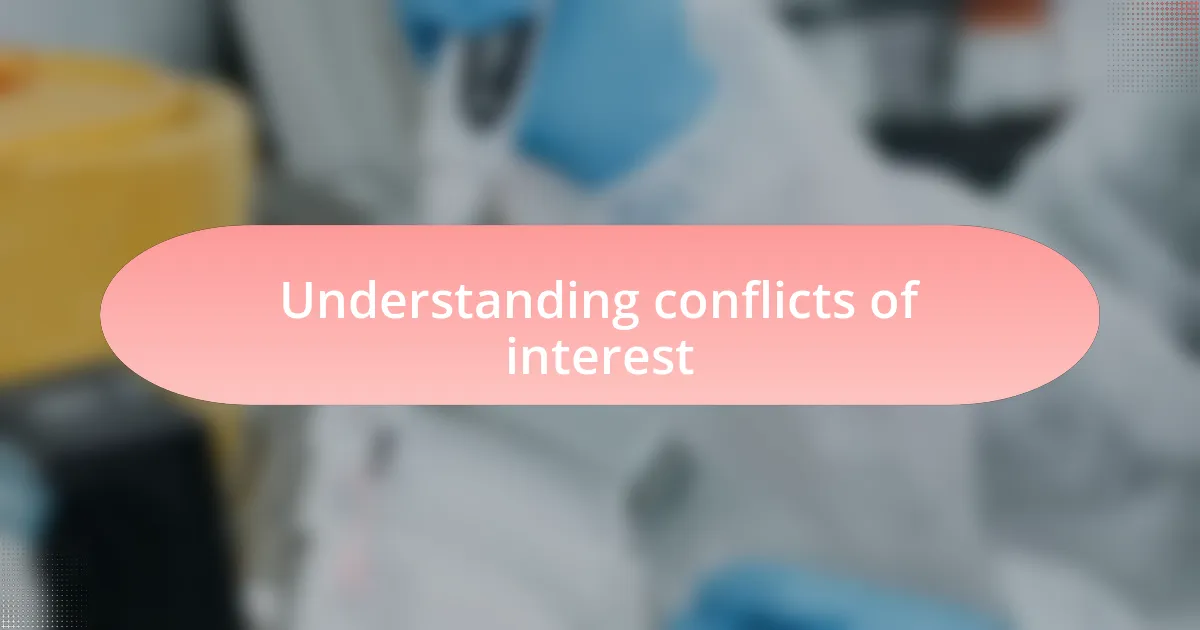
Understanding conflicts of interest
Conflicts of interest (COIs) can lurk in the background of research, often unnoticed until they influence outcomes. I remember a time during a project when I found out that a colleague had financial ties to a pharmaceutical company whose drug we were studying. It made me question our findings and the integrity of the entire research process. How can we trust results if the motivations behind them are clouded by external interests?
The emotional weight of recognizing a conflict of interest can be overwhelming. In my experience, acknowledging these conflicts requires a level of vulnerability and honesty that isn’t easy to confront. Have you ever felt torn between your professional integrity and personal incentives? That tension is often the first step toward ensuring research is conducted ethically and transparently.
Understanding the nuances of COIs isn’t just about identifying wrongdoing; it’s about fostering a culture of accountability in research. I’ve seen how teams that openly discuss potential conflicts tend to produce more credible and trustworthy work. Don’t we all want to contribute to a body of research that not only advances science but also prioritizes ethical standards and public trust?

Importance in medical research
The importance of navigating conflicts of interest in medical research cannot be overstated. When I reflect on my past projects, I recall the times when transparency about funding sources made a significant difference in how our findings were received. It’s critical that researchers disclose any potential conflicts to maintain the integrity of their work. How would you feel if you learned a groundbreaking study had hidden financial motives?
In my experiences, maintaining clear boundaries between personal interests and research objectives lays the groundwork for trust among peers and the public. I remember collaborating on a study where prior disclosures allowed us to openly address concerns and focus on the science rather than assumptions. This openness often turns challenges into opportunities for discourse, ultimately enriching the research process.
Moreover, addressing conflicts of interest head-on serves as a form of insurance against criticism and skepticism. Once, I worked on a project that faced public backlash due to undisclosed ties. It taught me that vulnerability in sharing these conflicts could not only safeguard our credibility but also strengthen the overall scientific community. If we prioritize ethical practices and bolster our commitment to transparency, won’t we help advance the quality and trustworthiness of medical research?
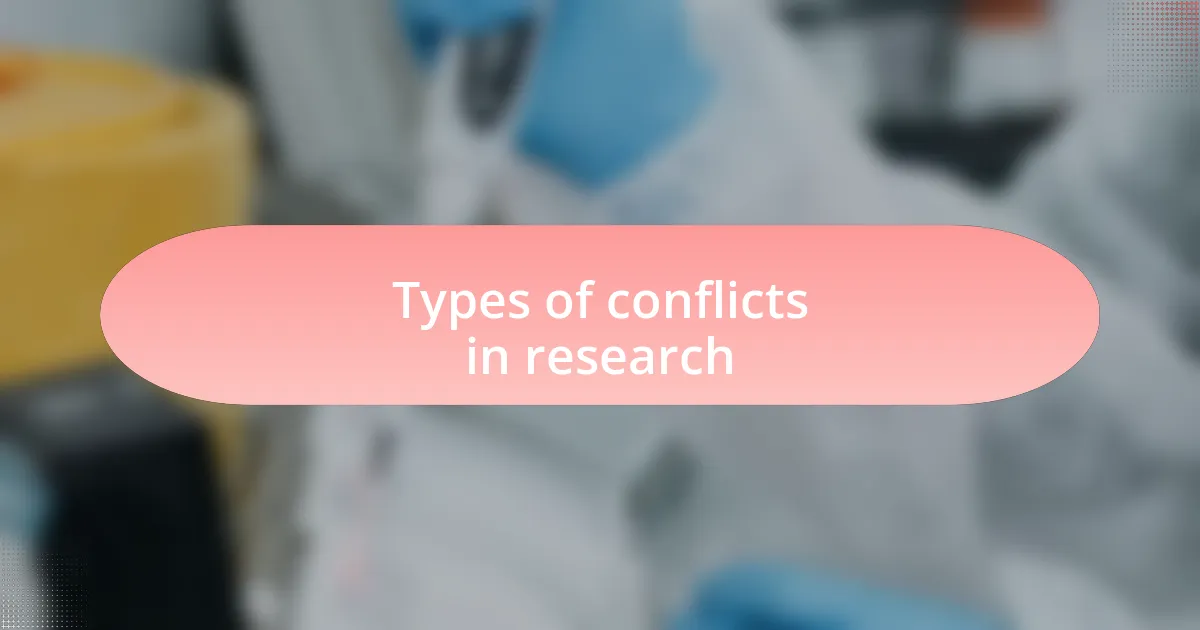
Types of conflicts in research
Conflicts of interest in research can usually be categorized into a few key types. One common type is financial conflicts, where funding from companies or organizations can influence study outcomes. I once worked on a clinical trial partially funded by a pharmaceutical company, and I vividly remember the careful scrutiny our team faced because of it. The experience highlighted the necessity of full disclosure to mitigate skepticism from both the scientific community and the public.
Another type is personal conflicts, which can arise when a researcher has emotional or social ties that could affect their objectivity. In one particular instance, I collaborated with a close friend on a study. This connection made it challenging to separate personal biases from scientific analysis. It was a learning moment, reminding me that even well-intentioned relationships can cloud judgment and the importance of establishing boundaries in research.
Lastly, institutional conflicts can emerge when a researcher’s affiliation with a university or a hospital could sway the research results. I’ve seen this first-hand in a project where faculty members felt pressured to align findings with their institution’s interests. This raised the question: how do we ensure that institutional affiliations do not compromise research integrity? It made me realize that self-awareness and ongoing dialogue about potential biases are crucial in navigating these complex waters.
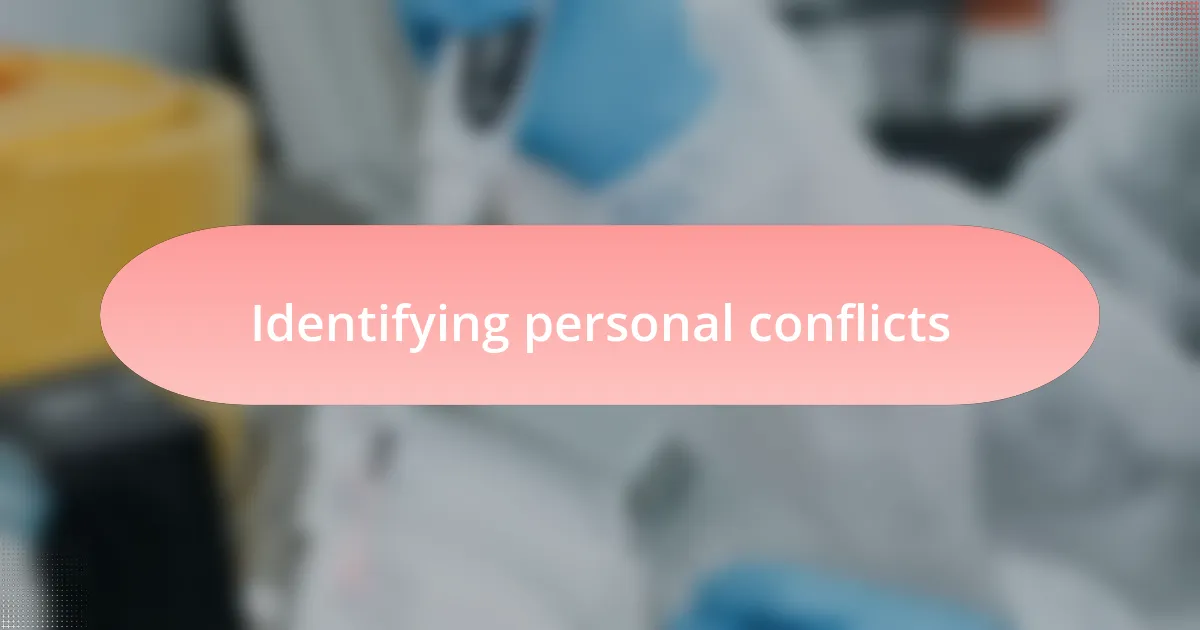
Identifying personal conflicts
Identifying personal conflicts in research often begins with self-reflection. I remember a time when I was involved in a project alongside a mentor who had significantly influenced my career path. This connection made it difficult for me to challenge their ideas, even when I had reservations. It got me thinking: how do we balance respect for those we admire with our duty to uphold research integrity?
One effective approach I’ve found is to regularly assess my emotional ties to the projects I undertake. When I start to feel overly attached to certain outcomes, it’s a signal for me to step back. I once had to reassess my involvement in a study that aligned closely with my personal beliefs. Asking myself tough questions about my biases was crucial in maintaining objectivity and ensuring the research remained credible.
Moreover, discussing potential conflicts with colleagues can foster a culture of transparency. I recall a situation where sharing my concerns with a peer led to a constructive dialogue that ultimately enhanced our research quality. It reinforced the idea that acknowledging these conflicts isn’t a sign of weakness but an essential step toward ensuring rigorous science. Why not open up about these challenges? The insights gained can be invaluable.
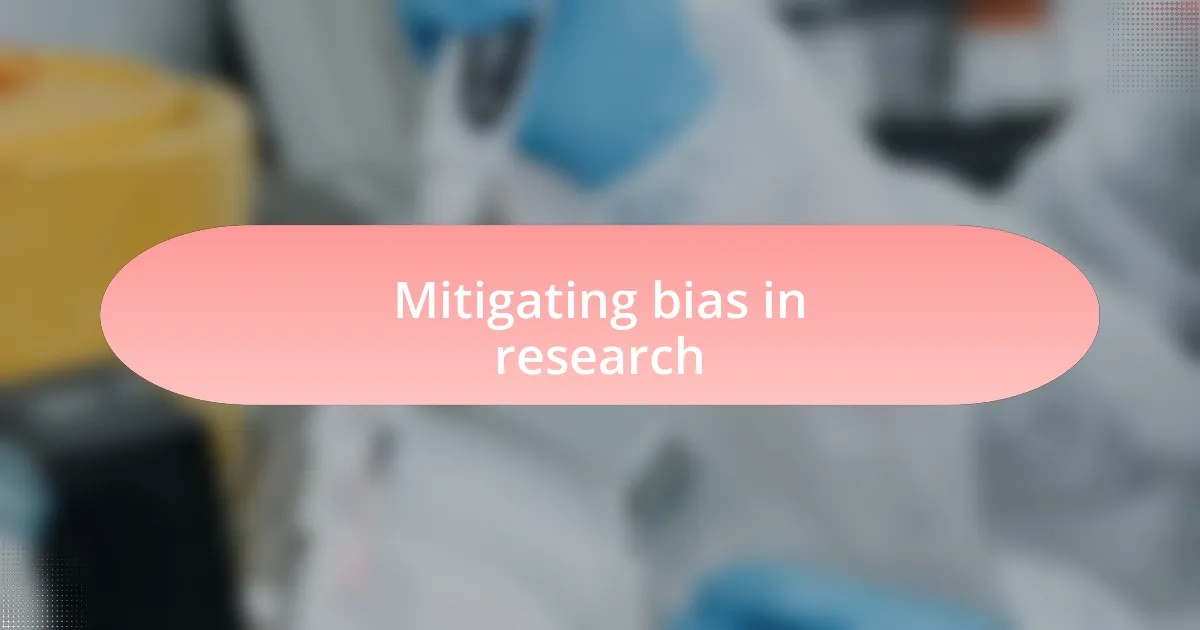
Mitigating bias in research
Mitigating bias in research requires a conscious effort to embrace diverse perspectives. I remember collaborating on a multidisciplinary project where we purposely included team members from various backgrounds. This approach not only enriched our discussions but also challenged my preconceived notions. Have you ever considered how different viewpoints can uncover blind spots in your work? From that experience, I learned that diversity is a powerful tool in combating bias and enhancing the quality of our findings.
Sometimes, employing structured methodologies can help minimize subjective influence. For instance, I once used randomized control trials in a study to eliminate biases that might stem from personal preferences. The clarity of a systematic approach made it easier for me to trust the results, demonstrating that objectivity can stem from rigorous planning. Don’t you think it’s fascinating that by following specific protocols, we can create a more level playing field in our research?
Additionally, I’ve found that seeking feedback from external reviewers can dramatically reduce the likelihood of bias. During a recent project, I invited a colleague from another institution to critique my work. Their fresh perspective highlighted assumptions I was unaware of and made me rethink parts of my study. It struck me how valuable it is to invite constructive criticism—why wouldn’t we want to fortify our research with insights from others? Embracing this practice can be a game-changer in maintaining integrity in our scientific endeavors.
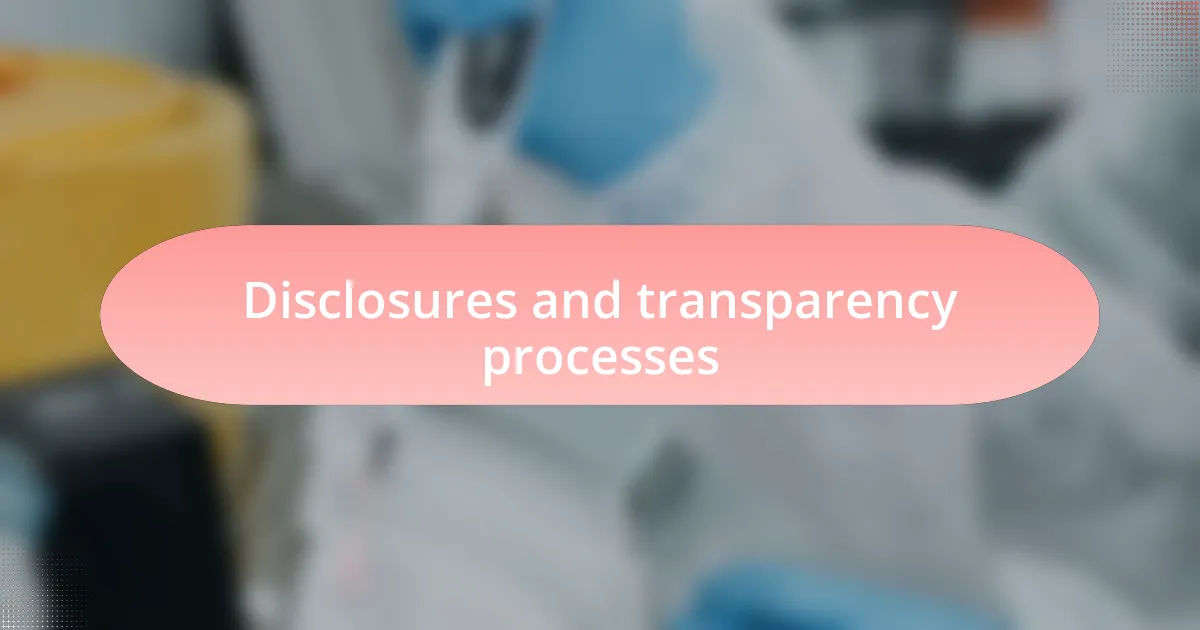
Disclosures and transparency processes
Disclosures and transparency are paramount in research, as they build trust and credibility. I remember presenting my findings at a conference and feeling a surge of responsibility when disclosing potential conflicts to the audience. It truly impressed upon me how transparency shapes the perception of integrity in our work—have you ever thought about how your disclosures could affect others’ trust in your results?
In my experience, establishing a clear disclosure process can be transformative. After implementing a formal policy in my laboratory, I noticed a change in the culture of openness within my team. Everyone began to share their affiliations and financial interests without hesitation, fostering a sense of collective responsibility. Isn’t it interesting how a simple process can cultivate an environment where honesty thrives?
Moreover, I’ve realized that maintaining transparency doesn’t just keep us accountable; it also invites collaboration. In a recent project, openly sharing our funding sources with potential partners led to fruitful discussions about shared goals. This experience reinforced my belief: embracing transparency not only mitigates conflicts of interest but also enriches our research community. How has transparency impacted your collaborations?
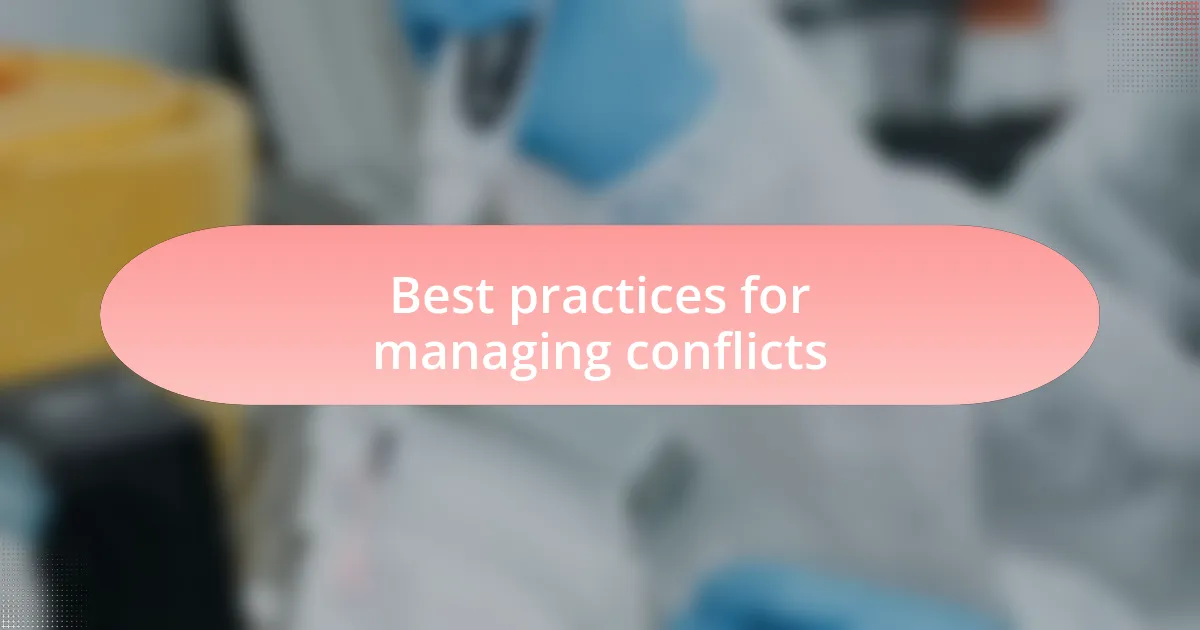
Best practices for managing conflicts
Best practices for managing conflicts require proactive engagement and regular dialogue among research team members. I’ve found that scheduling routine meetings dedicated to discussing potential conflicts can create a safer space for open conversations. Reflecting on my own practice, I remember how these discussions transformed our dynamics; we became more attuned to each other’s interests and concerns, which ultimately strengthened our collaborative efforts. Have you ever considered how regular check-ins could empower your team to address conflicts before they escalate?
Setting clear policies is another essential practice for managing conflicts of interest. When I began outlining specific guidelines within our research group, I witnessed a remarkable shift—team members felt a greater sense of ownership over their ethical responsibilities. Suddenly, it wasn’t just about compliance; it was about genuinely wanting to uphold the integrity of our work. What policies could you implement to foster that same sense of accountability in your own environment?
Additionally, utilizing external review processes can add an impartial perspective to help navigate conflicts. I recall incorporating peer review feedback before submitting a paper, which revealed underlying biases I hadn’t recognized. The process contributed to a more balanced presentation of our findings—not just improving the quality of our research, but also reinforcing my commitment to ethical standards. Have you ever had that “aha” moment where external insights change your approach to a conflict?